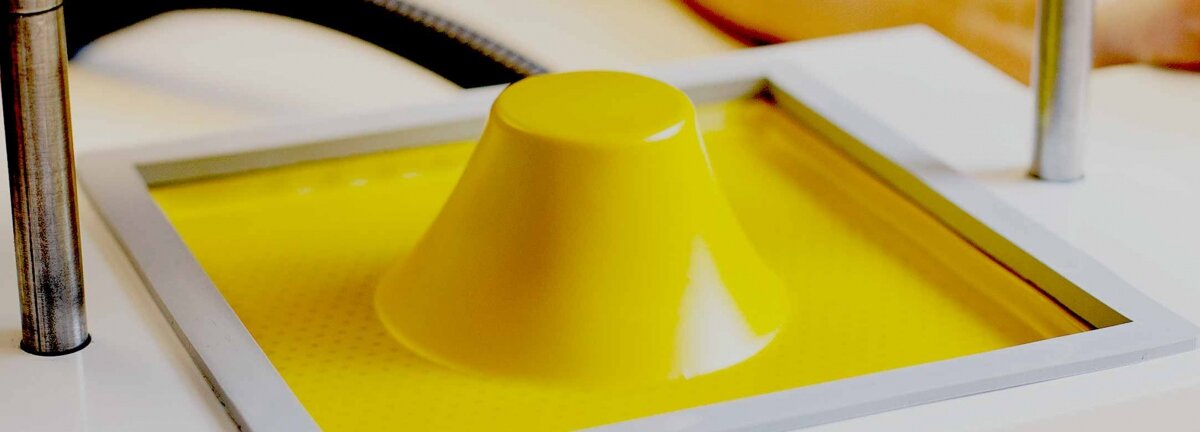Mayku: Bringing the factory to your tabletop

Spark finalists from 2015, Mayku are on a mission to revolutionise the experience of designing and making from home. Their desktop vacuum former is already a crowdfunding success story, with an ever-growing online community of FormBox Fans. Ben Redford, one half of the Mayku team, spoke to us about becoming an inventor and harnessing the power of the internet to help take their tabletop factory to market.
Desktop pioneer or mold-making phenomena?
A bit of both? Vacuum forming itself is nothing new. It's a commonly used in factories to create large everyday objects such as road signs, kiosks, ATM's etc. A huge plastic sheet melts to a mold and presto, it's filled, dried and ready for use. What we have 'pioneered' as such is to emulate the process of the large scale machine, but to make it compact and accessible enough for designers to use at home or in the studio. Its small size (measuring 18”x10”x12 - roughly that of a file box) means it fits nicely on a desk or table, and all you need to power it is a vacuum cleaner.
Designers know there is a huge benefit to being able to make from home. It means you can take control of the production process- rather than having to send your designs half way across the world. It also eliminates the issues of having to place a minimum order with a large factory.
Lightbulb moment or long time coming?
Definitely the latter. FormBox was actually my final year degree project while I was a student at Goldsmiths. I built a prototype for the degree show but then once I left university and got a job it lay dormant for a while. Fast forward three years to Shenzhen, China, where I was developing a product for work, and while touring factories there I happened to see a massive vacuum former in use. I thought about my idea and felt more than ever that there was still untapped potential in a desktop version. So when I returned home I quit my job and went back to developing the FormBox full time. Alex (Smilansky, a former colleague) came on board and together we created Mayku.
Invention novice or veteran?
A little in between. Alex has worked up concepts for smartphones and connected objects during his time at Mint Digital. He's also created multiple digital products for clients such as the Cabinet Office, Tesco and multiple experimental projects, including Upvoter, a communal voting platform launched as an internal project at Mint Digital.
I have shipped multiple products before - Projecteo the mini Instagram projector, Internetopia - the largest crowdsourced drawing in the world, and Olly and Polly - an experimental pair of Twitter connected robots.
Mentoring or Funding?
We entered Spark because we had a working prototype of the FormBox but needed funding and support to take it to the next level. We used the funds to build up to a Kickstarter campaign for the FormBox, which was a core part of our business strategy. However, much to our surprise, while the funding was hugely beneficial, it was actually the business advice that we got from the sessions at the Design Council that proved the most useful. I've got a design background, not a business one, so the things we learnt from industry veterans in those sessions were just invaluable.
Twitter or Facebook?
Why choose? It's all there for you to take advantage of. We targeted all forms of social media and I stand by that. However, I have to say we were completely swept away by the success we found on Facebook. Not long after we launched on Kickstarter our product was taken up by a fairly niche French blog. They posted it on Facebook and then it just took off. From that one post we received 12 million views! From there we sold 40-50 machines. It just blew us away. Other than that we've been most surprised by the uptake on Instagram. People really respond to images of the machine and the creations that you can make from it.
Traditional funding or crowdfunding?
We opted for crowd funding method of Kickstarter. It's a really great place to test the validity of a product before investing too heavily in production tooling and costs. It's also an incredible community of makers. By launching a Kickstarter campaign, we were able to build a community of early adopters, assess whether there is demand for our product and raise enough capital to invest in the tooling to enable us to make the FormBox at scale. We also chose this option because I had experience with Kickstarter from other projects and I felt confident that I could take the lessons I had learnt in the past, and really make it work for us this time. We’re now £400k over which makes us nine times funded. So now the pressure is really on!
Top tip in ten words:
Don't be precious. Be open. Take advice & ask for help.
Subscribe to our newsletter
Want to keep up with the latest from the Design Council?
